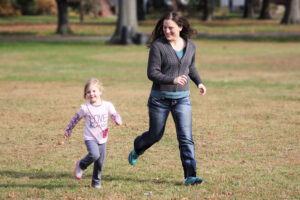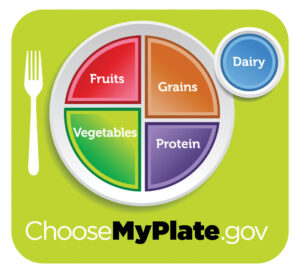 Running for fun? No way! Spending time in the gym? Yeah, right! Eating food for fuel? Seriously? I was the girl who hated physical education and didn’t play sports. Junk food was the only food category I wasn’t picky about, and I had no health concerns or weight issues.
Running for fun? No way! Spending time in the gym? Yeah, right! Eating food for fuel? Seriously? I was the girl who hated physical education and didn’t play sports. Junk food was the only food category I wasn’t picky about, and I had no health concerns or weight issues.
Keeping secrets
How things can change. Fast-forward a decade or so. I gained weight, was tired all the time and tried to make light of it. I used to laugh it off and say, “At 5 feet 2 inches and 174 pounds, I’m under tall, not overweight.” Guess the joke was on me. The scale tipped closer to the 200 line than the 126 pounds still on my driver’s license.
That was in 2009. I wore clothes to camouflage the rolls. I found out later the big, bulky shirts and stretchy pants served as a way for me to hide myself, and it was more than extra pounds. I added layers to help cover my sadness, anger, resentment, food addiction, financial woes and more.
Few people knew any of that. Most saw me as healthy, happy and confident. Like drug and alcohol addiction, food addiction is a serious problem. I know firsthand. You could call me a junk food junkie, chocoholic and sugar addict – names usually spoken whimsically. However, for the food-addicted person who stuffs bags of chocolates or cookies in the nightstand for binging or stops at the drive-through for a double cheeseburger and a shake on the way home from work before dinner, and also eats the full dinner, it’s no joke. I’ve gone through the drive-through and then hidden the empty bag and cup so no one would know.
Mental, emotional and spiritual issues can become prevalent for someone with weight-related issues. Depression, feeling unworthy. These breakdowns in our minds and hearts can lead to isolation and withdrawal from others, even the positive relationships. The good news? There are resources to help you move forward.
Leading by example
My husband, Mike, a physical education teacher and a basketball coach at the time, went through his own health crisis. He was overweight, run-down, taking three blood pressure medications and often barely had the energy to get through the day. He also had issues with sugar. Diabetes and hypoglycemia run in his family.
We ate fast food. Most of our meals came from a box, a bag, the freezer or a drive-through. It was mostly processed food, full of sugar and fat. We loved it. Plus, it was easy and cheap.
When Mike and I met in 1990, he was active, playing softball. Later, he played men’s recreational basketball until his legs and ankles got the better of him – too much wear and tear. His weight had also increased, which led to surgeries – knee, both Achilles’ heels and the removal of a bone spur. He was benched for a whi le but returned to the basketball court later.
le but returned to the basketball court later.
Still overweight, his doctor scolded him about his blood pressure and warned he was a ticking time bomb waiting to explode. Then another year, another physical and a new doctor with a fresh approach. The doctor asked him directly, “Are you leading by example?” Referring to how he was living in front of his students and players … those he was teaching and coaching toward healthy lifestyles.
That question clicked in his head, and the answer was an emphatic, “No!” His transformation began that night. He joined a gym and cleared our kitchen of junk food, replacing it with healthier, whole foods. Subway became our fast-food choice. We started eating at home – more salads, fruits and vegetables, lean meat. There was no magic formula or pill. It was hard work, discipline and an intentional new mindset.
Reality check
That single question was his reality check. It was hard to swallow, as are the national statistics. The U.S. has one of the highest percentages of obesity in the world. According to reports from the National Center for Disease Control and Prevention (CDC), nearly 40 percent (almost 94 million) of adults and 18.5 percent (13.7 million) of children and adolescents are obese.
The CDC estimates if things don’t change by 2030, there will be a new reality, and it will affect younger generations, too. Half of U.S. teenagers will be overweight or obese. One third of kids between 6 and 11 years old will fall into the same category. In fact, more than 57 percent of today’s children will be obese by the time they are 35.
Mike and I had fallen into the unhealthy category. He stepped up first to make the necessary changes. I was still on the fence.
At a dinner with my co-workers, someone asked Mike how much weight he had lost. I was busily chatting with someone else when I heard him respond, “About 50 pounds.” I spun around, shocked. “You’ve lost 50 pounds?” He smiled.
How did he do it? He changed the way he thought. He made better food choices, eating habits and added exercise. In the process he lost a total of 85 pounds. I knew he had made changes, but seeing him every day, I hadn’t truly noticed the physical results.
I begrudgingly started going to the gym with him, but only in a neighboring town so I wouldn’t run into people I knew. I was afraid I’d make a fool of myself. At that time, the machines were intimidating. I was sure I would fly off a treadmill, drop a dumbbell on my head or something worse. What we worry about or envision as obstacles often get in the way of what is possible.
Change your mindset
Healthy starts from the inside out. It starts with small steps and changing your thought patterns. Start by writing down your health goals. Make them SMART – Specific. Measurable. Attainable. Realistic. Time-based. (i.e., I will lose 15 pounds by Easter, exercise three to five days a week and eat healthy based on the ChooseMyPlate model for my specific health profile. Visit ChooseMyPlate.gov for details.)
Sonya Jones, former “Biggest Loser” finalist and outreach representative for HSHS Medical Group in Springfield, Ill., spent six months on “The Biggest Loser” show and four months on the Biggest Loser Ranch learning about healthy living.
While we don’t all have that option, Jones advises, “Don’t just view health and wellness as weight loss. Weight loss is part of it, but true health and wellness is being healthy in body, mind and spirit. Work on the spiritual. Work on the emotional. Work on the mental. And, of course, work on the physical as well. As I shrunk physically, I grew emotionally, mentally and spiritually, and that’s where the real win came for me. Get healthy in all areas of your life!”
Rewards for healthy living
That’s what I did. Finally, in 2012, I was making huge strides in my own health journey. I began enjoying my workouts and made healthier food choices and created good habits. I lost 40-plus pounds and kept it off. My energy levels climbed. My attitude shifted from negative to positive. People at the gym started asking for my help.
Suddenly, I was an example of good physical health. I decided to go a step further in 2013 and earned certifications as a personal trainer and specialist in fitness nutrition through the International Sports Sciences Association (ISSA) so I could coach others. Most recently, I earned the ACE (American Council of Exercise) personal trainer certification.
The cost of poor health
It may surprise you to know the impact poor health has on the economy. Economic pressures for businesses, organizations, communities, households and schools are growing exponentially due to health-related issues.
Insurance costs continue to rise, in general. Add obesity-related diseases to the mix, and the cost increases dramatically. This is largely due to diseases that often occur when a person is not healthy – strokes, asthma, heart attacks and other cardiovascular diseases, to name a few.
According to the CDC, an obese person in America incurs an average of $1,429 more in medical expenses annually. More than $147 billion is spent in added medical expenses per year within the U. S. and may increase approximately $1.24 billion per year until the year 2030.
Influence the next generation

Before being on “The Biggest Loser,” Jones spent 19 years in education. She taught elementary physical education, coached junior high softball and high school track. She also served as athletic director at a school. While she personally knows the effects of being overweight, she has also noticed it in our younger generations.
“Among children and youth, I’ve seen some good changes and some bad changes. I’ve seen students who start playing sports at a younger age and desire to do well in them. It’s caused them to be more physically active at a younger age, which has fostered a deep desire to remain active and competitive as they grow older,” she explains. “On the flip side, I’ve seen other students become less engaged in physical activity and instead focus more on screen time and video games.
“Get your children involved,” continues Jones. “Encourage them to be active with their friends. Get on a team. Do activities with them … that’s huge. Don’t just demand that kids go outside and play … go outside and play with them.”
That is one of the things Mike and I have done. Our three adult children have watched us learn to make healthy choices and have made changes themselves. We also make sure our grandson and granddaughter, both toddlers, see fitness as fun. We want to help them create a life-long love for it.
One of our favorite activities with them is to grab our bright yellow bucket and go on a nature walk. I ask them to collect treasures: an acorn, yellow flower, red leaf, round rock, whatever is plentiful. It activates their minds and bodies and allows quality time together without the distraction of toys and electronics. It’s something we can continue as they get older, though they may not always carry the yellow bucket.
You can do the same. Help your family change the trajectory for future generations. You don’t have to deprive your family of treats or be on the go every minute. Be cognizant of the choices you help them make. Be intentionally active. Below is a list of suggestions – things we have had success with through the years.
- Don’t allow your toddlers or teens to mindlessly snack while sitting in front of the TV.
- Don’t reward your child for a job well done with unhealthy foods.
- Don’t let your teenagers spend all their time playing video games or texting.
- Do sit down at the table together. Bring back the tradition of the family meal.
- Do reward smart choices with age-appropriate activities. Take a trip to the zoo. Play at the park. Go for a bike ride or long walk with your tweens and teens. Ask for their suggestions.
- Don’t make it complicated.
- Do create simple, fun adventures. When you go for a walk, have the younger children yell out “march, walk, hop, skip, run!” You can call out the moves and do them, too.
- Change is possible
Are you ready to move forward? Jones says the best thing to do is, “Start! Start now! And believe in yourself. If you think you can, you’re right. If you think you can’t, you’re right. Believe you can make a change, develop a plan and go get it. Don’t make a hundred changes at once … just make some changes you can incorporate into your daily life. Don’t go on some fad diet to lose a lot of weight … it always comes back on. Do something you can continue to do throughout your life.”
Yes! It’s a matter of choice. Change your mind. Change your habits. Change your life.
Streamline your grocery shopping
Follow these basic guidelines, and you’ll be off to a great start.
- Determine your weekly needs by planning your menu ahead of time. Mix up the meals. Allow each member of the family a choice.
- Keep a running grocery list. What foods, spices or other ingredients are needed for the week? Write it down, type it up or use a grocery app.
- Group your foods to match the layout of the store.
- Review your household’s weekly schedule. Decide who will be home when, so you know the number of mouths you are feeding at any given time throughout the week.
- Shop the outer perimeter of the grocery story for the healthiest ingredients. That’s where you will find produce, meat and dairy.
10 tips on how to shop smart for fruits and veggies (ChooseMyPlate.gov)
- Celebrate the season – use vegetables and fruits that are in season.
- Don’t pay full price – check store ads and manufacturer’s coupons.
- Stick to your list – it will save you time and money.
- Try canned or frozen – choose items without syrup or added salt.
- Buy small amounts frequently – keeps waste down, saving money.
- Buy in bulk when items are on sale.
- Save money with store brands.
- Keep it simple – buy produce in its simplest form.
- Get it fresh – plant a garden.
- Plan and cook smart – pre-cook foods in bulk, package and freeze.
Nutrition is key to good health
Your body is an intricate system that needs the right kind of fuel to run properly. Good nutrition is the place to start, and it isn’t as difficult as we often make it. Guidelines set by the Food and Drug Administration (FDA) are simple.
- Fill your plate with vegetables and fruits. Choose from a rainbow of bright colors; they are full of nutrients to help boost your energy.
- Include lean proteins. Beef, chicken, pork, turkey, even beans and tofu. Twice a week, make seafood your choice of protein.
- Get your calcium. Drink a cup of fat-free or low-fat milk. You’ll benefit from the same amount of calcium with less calories and fat.
- Make half your grains whole grains.
- Use healthy fats such as canola oil, olive oil and nonstick vegetable spray for cooking.
- Replace sweets with fruit – strawberries, apples, orange slices. It’s okay to grab frozen or canned but be sure they aren’t in syrup. Get produce in its most natural state.
- Exchange chips and dip with veggies and dip. Fresh veggies are always best.
- Use spices and herbs to flavor your foods, rather than adding sugar and salt.
- Prepare foods in advance, so you don’t grab convenience foods that aren’t as healthy.
- Read the nutrition label.
- Understand the nutrition label
Read the nutrition label as you shop so you know what’s in your food. The FDA updated it for packaged foods and beverages in May 2016, its first revision in 20 years.
It is now easier to understand so you can make more informed food choices. It still includes calories, serving sizes, daily value percentages, nutrients and ingredients. Everything is based on new scientific research – one of the reasons “added sugars” is now included.
For detailed information about nutrition label changes visit fda.gov.









